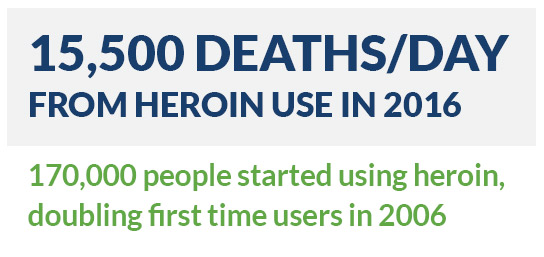Heroin Treatment and Rehab
Heroin is a derivative of morphine naturally found in the opium poppy (Papaver somniferum) plant but considered approximately three times more potent. Classified as a Schedule 1 illicit narcotic by the Drug Enforcement Agency (DEA) in accordance with the Controlled Substance Act of 1970, heroin is unavailable to the general public through legal, medically acceptable channels. Heroin targets the central nervous system (CNS), penetrating the blood-brain barrier and producing an intense euphoria.
Typically, pure heroin is sold on the street as a bitter-tasting white powder, however; it is often laced with other illicit drugs or household substances such as sugar, starch, quinine, and powdered milk. The drug can also be laced with cheap poisons like strychnine, on account of dealers’ intent to maximize profits. Such improper mixture dramatically increases the risk of overdose and death associated with the drug. “Black tar” heroin, another popular variety, is dark brown or black and sold as a sticky gel or congealed coal-like substance.
Heroin is frequently injected intravenously, although it is also vaporized, snorted, ingested orally or used as a suppository. The infamous heroin “high” is usually associated with injection, but all methods of use produce an intensely euphoric state, which is why users are willing to pay exorbitant prices despite the deadly risks associated with even singular use. Heroin, known in street slang as “dope,” “junk,” “smack,” “horse,” “snow,” “tar” “mud” and “dragon,” is often the next outlet for those already hooked on prescription painkillers. (These over-prescribed and excessively abused opiates serve as gateway drugs.)
Health Hazards of Heroin
Heroin works through a mechanism similar to other opiates by binding to opiate receptors in the brain and CNS. The drug achieves this binding process by first metabolizing to morphine, which serves as an intermediary and contributes to the potent high that soon follows. Many users report experiencing an overwhelming euphoria within minutes or even seconds after injection. This intense rush of pleasure—the result of artificially elevated dopamine levels in the brain—is usually accompanied by dry mouth and hot flushing of the skin, both of which are highly alarming and extremely uncomfortable. Once the initial euphoria peaks and begins to subside, users alternate between a keenly alert and drowsy state of consciousness. In this paradoxical state, mental clarity and cognitive function begin to rapidly decline as the damaging, disorienting effects of the drug set in.
The depressant effect heroin has on the CNS triggers a host of adverse reactions including respiratory malfunction, hypotension, convulsions, nausea, constricted pupils, muscle spasms and disorientation. Even when the threshold associated with heroin overdose has not been reached, the drug is still capable of producing a debilitating and potentially deadly backlash. Intravenous injection poses particularly extreme risks.
Contaminated needles and unsanitary injection practices may lead to the following:
- Hepatitis C
- Endocarditis (inflammation of heart lining and valves)
- Collapsed veins
- The spread of HIV/AIDS
- Painful oral abscesses
- Coma and/or death
Following the same downward trajectory as other illicit drugs, once a user becomes heroin-tolerant, greater and greater quantities must be used to achieve the desired effect. By the time full-blown addiction sets in, serious withdrawal symptoms are unavoidable. Even in cases of mild dependence, users will suffer from an onslaught of unwanted and potentially debilitating symptoms. In many users, withdrawal symptoms may occur in as few as four hours following dosage, typically peaking within 48 to 72 hours and subsiding within one week. During this period, the following cluster of symptoms may develop:
[one-half-first]
- Intense cravings
- Restlessness
- Psychosis
- Disorientation
- Insomnia
[/one-half-first][one-half]
- Diarrhea
- Vomiting
- Muscle and joint pain
- Cold flashes
- Tremors
[/one-half][clearfix]
STATISTICAL OVERVIEW

In addition to the rapidly accumulating death toll, heroin is responsible for escalating violence, over-taxing an excessively costly criminal justice system, and creating a disturbing counterculture of illicit manufacturing (diversion) practices. Although previous opiate dependence is the greatest predictive risk factor associated with heroin addiction, polysubstance abuse is also a significant cause. Statistical averages reveal the following two certainties:
- More than 9 in 10 heroin users also used at least one—and usually multiple— recreational drugs.
- Approximately three out of four new heroin users report previous prescription opiate abuse.
Demographics for Heroin Use
Heroin is a lethal poison that knows no limits. Anyone, at any time, regardless of age, socioeconomic status, religion, political orientation, sexuality or occupation can fall victim to its deadly charms. Once erroneously believed to be a hard-core street drug used almost exclusively by a criminal element, heroin use is as prevalent among ordinary, working-class citizens as it is among the wealthy and famous.
A spate of recent celebrity deaths shed new light on the drug’s inherent dangers and brought evidence of the growing epidemic into pop culture awareness. Distinguished actors Phillip Seymour Hoffman and Cory Monteith both succumbed to overdoses as a result of heroin mixed with other drugs, just as legendary comedian John Belushi did years earlier as a result of a cocaine-infused heroin injection gone bad. Heroin dependency has doubled in the last decade—even among those with no previously known substance abuse disorders (SUDs) or genetic proclivity for addiction.
Undoubtedly, one of the most concerning aspects of America’s heroin epidemic is its debilitating effect on youth. Data obtained from the Monitoring the Future (MTF) surveys and the National Survey on Drug Use and Health (NSDUH) unanimously reported a surging trend among young adults ages 18 to 25. Between 2002 and 2005, first-time heroin users among this cohort were estimated at 39,000; but between 2009 and 2011, that number had increased to over 200,000, with some reports suggesting as many as 361,000 new users.
TREATMENT OPTIONS AND PHARMACOLOGICAL INTERVENTIONS
Heroin addiction is treated in a multitude of ways depending upon the frequency, intensity and duration of use. Evidence-based research corroborates the benefits of Food and Drug Administration (FDA)-approved medications in achieving optimal treatment outcomes. Since heroin abuse progressively hijacks healthy brain chemistry, pharmacological interventions are necessary to stabilize clients and prevent precipitated withdrawal, the potentially deadly acceleration and intensification of withdrawal symptoms. Regardless of what treatment option a client chooses, the following medications form the basis of effective symptom resolution and control:
Methadone – Used for over 25 years to treat heroin addiction, its use is highly regulated and based upon strict medical authorization and need. This once-per-day medication activates the same neurological receptors as heroin, but is considered controversial in light of its history of sales and abuse.
Suboxone – Used early in symptom onset, this combination of buprenorphine and naloxone (an opiate antagonist) is frequently used to help prevent intravenous buprenorphine abuse. This clinically proven medication for heroin dependence significantly lowers the risk of precipitated withdrawal. Suboxone activates the same neurological receptors as heroin and is generally well-tolerated.
Vivitrol – An injectable prescription variety of naltrexone that helps control cravings and stabilize psychological and physiological processes. The drug is available in both pill and once-per-month injectable form and works by blocking opiate receptors in the brain, noticeably diminishing the euphoric effects associated with heroin.
Subutex (buprenorphine) – produces a similar, but a less potent effect when compared to certain opiates, which helps reduce withdrawal symptoms and diminish cravings.
Medication-assisted treatment (MAT) may include additional medications used to treat concurrent anxiety and depression-related disorders in addition to the primary medications listed above. Clients benefit from evidence-based therapies geared toward resolving the psychological and emotional factors associated with heroin use. Licensed clinicians, in tandem with qualified medical professionals, help determine individual client needs after a comprehensive medical and psychiatric evaluation.
Cognitive behavioral therapy (CBT), motivational interviewing (MI), trauma-informed therapy, family therapy, dialectical behavioral therapy, and additional expressive therapies are all included in the scope of treatment to help ensure maximum benefit of the pharmacological interventions. Due to heroin’s highly addictive properties and insidious rewiring of brain chemistry, medication alone is not sufficient to produce long-term benefits post-treatment.
Post-treatment Success for Heroin Addiction
Staying motivated, enlisting family support, and maintaining a nutritious diet and regular exercise are all critical aspects of successful long-term recovery. One-on-one and/or group therapy and working a 12-Step (NA) program are also key components of a recovery lifestyle. The current relapse rate for people struggling with substance use disorders (SUDs)—including heroin specifically—is approximately 40 to 60 percent. Although people frequently associate relapse with failure, recovery is a journey that entails learning to rise above the inevitable challenges that accompany each step on the path. Heroin addiction, while daunting, is not insurmountable. In fact, less than 50 percent of heroin users who abstain from use for at least a year will relapse. Even more hopefully, less than 15 percent of people who abstain from use for at least five years will relapse.
Seeking Help for Heroin Abuse
If you or someone you love is struggling with heroin addiction, consult a substance abuse professional today and seek treatment— immediately. Heroin is a serious, potent and debilitating drug that can quickly turn deadly, but with detox and treatment, recovery is possible.
For more about heroin addiction and recovery, check out these related articles:
- Heroin Detox: What You Need to Know
- How to Help and Addict
- Why Early Intervention for Addiction is Critical
- How to Know if You Need Rehab Treatment
- The Link Between Addiction and Trauma
[expand title=” Sources:” targclass=”highlight”]
Annual Review of Public Health. The Prescription Opioid and Heroin Crises: A Public Health Approach to an Epidemic of Addiction. March, 2015.
The New England Journal of Medicine. Relationship between Nonmedical Prescription—Opioid Use and Heroin Use. Jan, 2016.
The Clinical Journal of the American Society of Nephrology (CJASN). Chronic Neuropathies of Cocaine and Heroin Abuse: A Critical Review. June, 2006.
Emergency Medical Journal (BMJ). Effect of inappropriate naltrexone use in a heroin misuser. Vol 20, 2003.
BMC Pediatrics. Opioid substitution treatment and heroin dependent adolescents: reductions in heroin use and treatment retention over twelve months. May, 2018.
[/expand]


